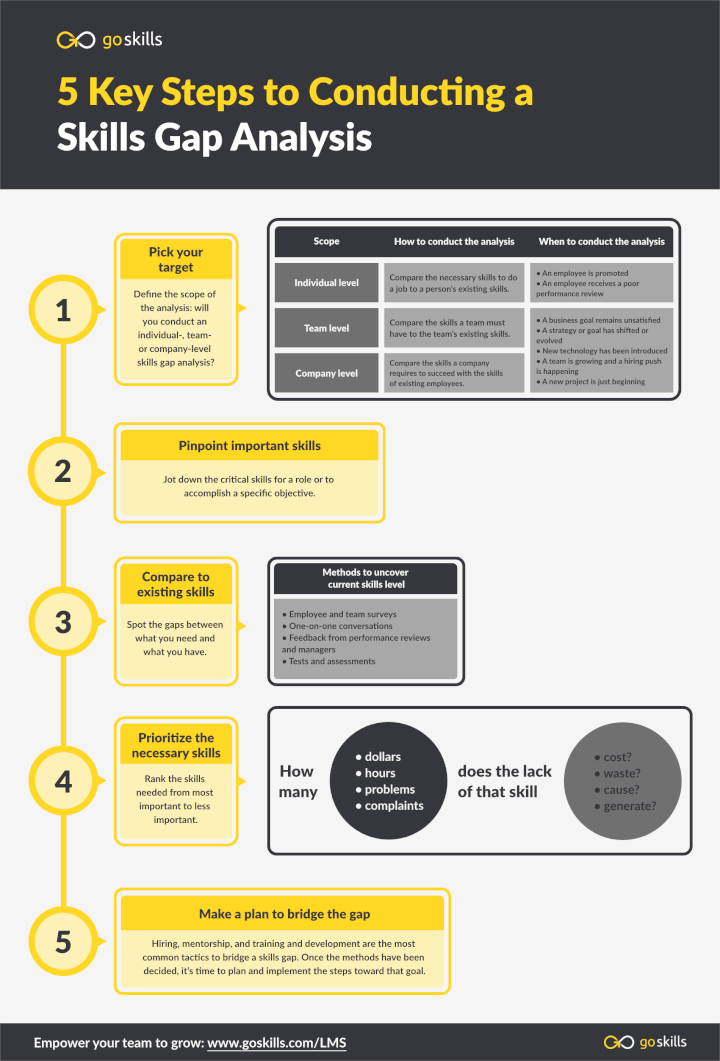Here’s a question for you to ponder: Just how skilled is your current workforce? Do they really have the necessary knowledge and competencies to do their jobs well?
If you can say with any degree of confidence that your own team is solid in this regard, you’re doing better than most. In fact, recent statistics show that up to 92% of business leaders think that American workers aren’t as skilled as they need to be.
Yikes. It’s a problem. But here’s the thing: As easy as it is to point the finger, this is ultimately your problem to fix. If you want a thriving organization, it’s your responsibility to take steps to help employees and your entire team fulfill their potential.
The best place to start? You can gain some much-needed clarity and direction by performing a skills gap analysis.

What exactly is a skills gap analysis?
It’s obvious that there’s a mismatch between the skills employers desire and the skills that their employees bring to the table. That’s exactly what a skills gap is—that incongruence between what’s needed and what’s possessed.
So, with that in mind, a skills gap analysis is a method that leaders and companies can use to pinpoint those skills gaps. That way, they can proactively address them and build a stronger team and organization.
Let’s set up an example for some clarity: CompanyXYZ is preparing to undertake a huge company-wide project. They’ll be rolling out an entirely new product, and it’s all hands on deck to pull this thing together.
They want to ensure that their roster is packed with the expertise they’ll need to make this project a success, so they’ve decided to perform a skills gap analysis first and foremost—to avoid any roadblocks or slowdowns later down the line.
How to perform a skills gap analysis for your team
You’re ready to roll up your sleeves and figure out what gaps you need to fill on your own team. But, how exactly do you get started? Below are five steps you can follow to complete your own skills gap analysis and build a stronger team.
1. Pick your target
A skills gap analysis can feel overwhelming—particularly when your objective is something vague like “figure out what skills our organization needs to thrive.” This process is far easier to manage if you take a more focused view.
We’ve already done that with our example: CompanyXYZ is going to figure out what specific skills they need to tackle a new product launch. But, rest assured, this isn’t the only circumstance when you can conduct a skills gap analysis. There’s a lot of flexibility here.
A skills gap analysis can be performed on a variety of levels, including:
- Individual: Comparing the skills necessary to do a job to the existing skills of a person
- Department or Team: Comparing the skills a team must have to the existing skills of the team
- Company-Wide: Comparing the skills a company requires to succeed with the skills of existing employees
Even further, as Workable eloquently explains, you might perform a skills gap analysis in a variety of different circumstances.
You might perform an individual skills gap analysis when…
- A candidate is being evaluated for a position
- An employee is promoted or takes on additional responsibilities
- An employee receives a poor performance review
- An employee repeatedly gets stuck or confused
- An employee is spearheading a challenging new project
You might perform a team or company-wide skills gap analysis when…
- A business goal remains unsatisfied
- A strategy or goal has shifted or evolved
- New technology has been introduced
- A team is growing and a hiring push is happening
- A new project is just beginning
That’s by no means a comprehensive list, but it certainly illustrates that a skills gap analysis can be helpful for a ton of different situations.
For the sake of simplicity, let’s stick with our example of CompanyXYZ’s initiative of launching a brand new product.

2. Pinpoint important skills
Next up, it’s time to figure out what skills you need under your belt, so to speak. This is your chance to jot down anything and everything that would be important for that specific role or objective.
In our hypothetical situation of bringing a new product to market, it’s decided that the following skills will be required to make that product launch a success:
- Market research
- Product development
- Prototyping
- Product testing and feedback
- Graphic design
- Copywriting
- Web development
All of those will be a core piece of the puzzle from product inception to delivery, so they all deserve a spot on CompanyXYZ’s wishlist.
3. Compare to existing skills
Remember, your goal wasn’t just to identify important skills—it was to spot the gaps between what you need and what you have. That’s exactly where this step comes in.
Are there any skills on your must-have list that this person or team doesn’t already possess? If so, which ones?
If you’re struggling to figure out exactly what knowledge and competencies you already have at your disposal, you can use a variety of formal and informal methods to get a better grasp on your employee’s or team’s current skill level, including:
- Employee and team surveys
- One-on-one conversations
- Feedback from performance reviews and managers
- Tests and assessments
In looking at their wishlist and their current team, CompanyXYZ realizes that they have almost all of their boxes checked—except for graphic design and copywriting. They also realize that essential Excel skills are lacking in many of their team members who work with spreadsheets almost daily.
Up until this point, they’ve worked with a random assortment of agencies and freelancers to get those responsibilities covered. But, doing so has also presented a lot of issues in terms of communication and collaboration. So, they’ve decided they’d rather bring those responsibilities back in-house.
4. Prioritize those necessary skills
This isn’t necessarily an issue using our simplified example of CompanyXYZ, but sometimes when conducting a skills gap analysis, you might realize that you’re lacking a lot of the skills required. What happens then?
Like anything else in the business world, it’s time to prioritize by ranking those skills from most important to least important.
Admittedly, this can be challenging (we get it—all of those skills seem important for your success!), so it’s helpful to develop some repeatable criteria you can use to fairly judge the immediate importance of those skills.
For example, when evaluating how pressing that skill gap is, you could consider:
- How many dollars is the lack of that skill costing?
- How many hours is the lack of that skill wasting?
- How many problems is the lack of that skill causing?
- How many complaints is the lack of that skill generating?
Again, the criteria you come up with is totally up to you (don’t hesitate to get creative!). But, in those situations where you realize you have a lot of skill gaps you need to fill, it’s important to have some sort of system in place to help you prioritize.

5. Make a plan to bridge the gap
Knowing that a gap exists is one thing—but it doesn’t do much good if you don’t put a plan in place to address it. If those skills are necessary, how will you go about finding or developing them?
There are a variety of tactics you could take to fill those gaps, including:
In the case of CompanyXYZ, maybe there’s somebody on the team who has a basic knowledge of copywriting and has expressed an interest in refining that skill set. They could offer some formal training and courses (GoSkills is great for this exact type of thing!) to help them take those skills up a level.
Or, maybe there’s a void in terms of graphic design competencies. At that point, they might look to hire a new team member who possesses strong design chops and experience with graphic design programs to meet that need.
There are a variety of ways you can bridge the skill gaps you identify. Just make sure you actually take steps to do so—that’s the most important part of the process.

Conduct a skills gap analysis and boost your team
Having a team that’s underqualified can inspire frustration, slow down your projects, and ultimately sabotage your success. Fortunately, conducting a skills gap analysis can help you target your efforts and make your team even stronger.
Follow the above five steps, and you’ll figure out the best place to go from here in regards to your hiring, training, and employee development. If you ask us, that’s a whole lot better than doing those things at random.
Check out the GoSkills LMS for courses that will level-up your team’s skills, as well as placement tests that will help you better identify strengths, weaknesses, and skill gaps.
Train any size team
It's easier than ever to track and manage your team's training with the GoSkills LMS.
Start for free



